Cycling in the Netherlands is like diving into a world of subtle cues and signals - the unwritten codes for cycling – to be learnt “on the saddle.”
Intricate canals and narrow, paved streets weave through the city, bordered by lush plants and flowers along tilted red-brick facades. The air carries the scent of fried delights, while the gentle hum of rolling tires is punctuated by the metallic “tring-tring” of bicycle bells. Amidst this scene, swarms of bicycles move in frenetic harmony, flowing seamlessly, pausing (most times) at the streetlights. Pedestrians, cyclists, and cars seem to coexist peacefully. A fantasy, you ask? No, just another day in a Dutch city!
If you haven’t yet experienced cycling in Dutch cities, you’ve surely heard of the country’s reputation as the cycling nation. Pedaling around is normalized to the point of constituting what Kuipers (2013) calls a “national habitus,” referring to non-state-led national similarity. Even the Dutch Prime Minister hops on his bike daily. If you grew up in the Netherlands, cycling is as common as talking about weather or drinking coffee. However, if you’re encountering Dutch cycling culture for the first time, there’s a lot to learn. It’s much more than simply putting on a helmet and hoping for the best (actually, you better not get started on helmets). With an expansive cycling network, you might think “That must be easy!” Eyes forward, stick to the lanes, obey the traffic signs. But there’s much more to it than that.
Cycling is like another form of walking
First things first; just like you would walk without thinking about wearing special clothes or gear, most people riding bicycles in the Netherlands do not wear technical clothing or accessories, including helmets. Would you ever put on a helmet or high-vis vest before walking or driving a car? What about the rain and snow, you ask? As the saying goes, there is no bad weather, only bad clothing. A simple poncho and rain pants will keep you dry.
Your bike is an Uber
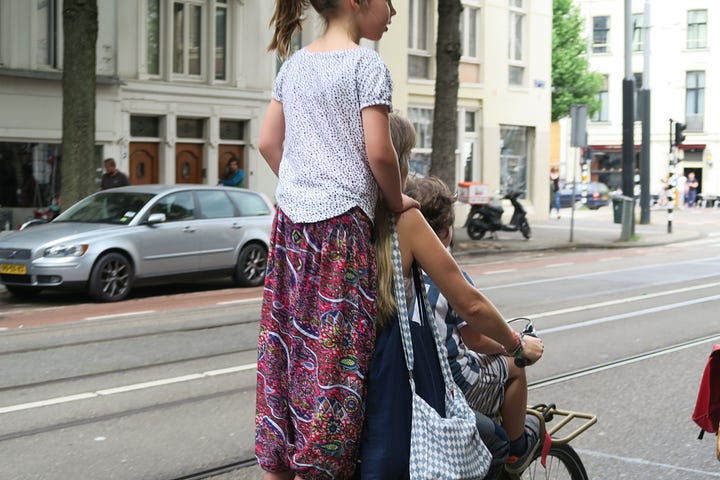
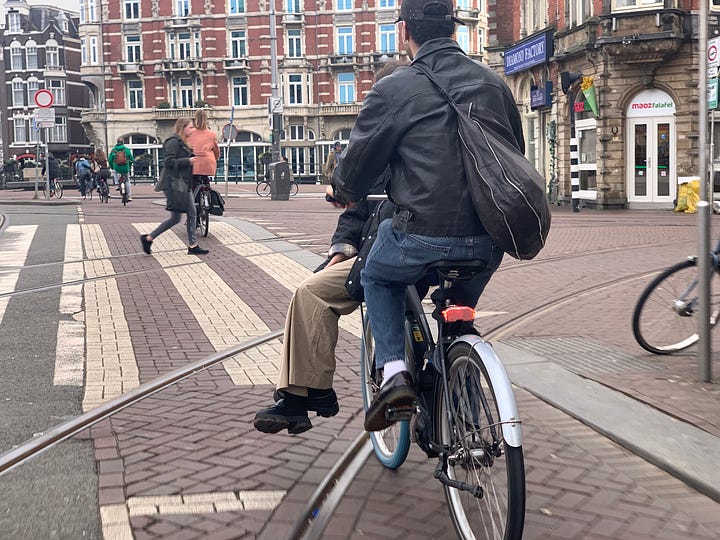
In the Netherlands, having an extra bike for your friend is not necessary. You’ll often see people hopping onto luggage racks or even handlebars for a ride. Gender is not relevant. Ladies often carry men. So don’t be surprised if your date picks you up on their rusty 5th hand Gazelle; can it get any more romantic than this? Of course, safety always comes first, and for little ones under 8, the only ones not allowed on the handlebars, a special child seat is required.
Your bike is functional, … and personal
Forget shiny racing bikes. Welcome creaky bells, wobbly fenders, and slightly wonky handlebars. So long as the brakes work and the tires roll, you’re good. But is this changing? Several people argue that the type of bike you own is also a marker of your identity: where you're from, what you're into, or even your position at work. While the second hand bikes that fall apart are much loved by students, cargo bike owners will likely be labeled as an elitist career-focused middle-class mum or dad (Boterman, 2020). A Swapfiets or rented bike? An expat?! A fatbike? A successful manager or director?
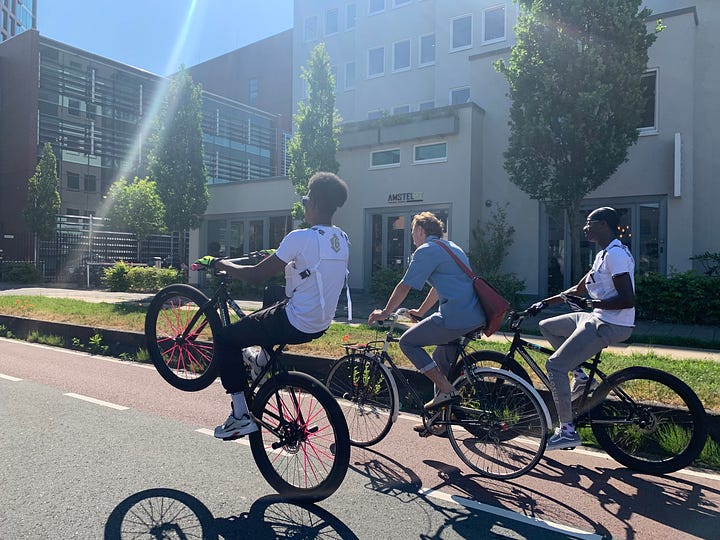
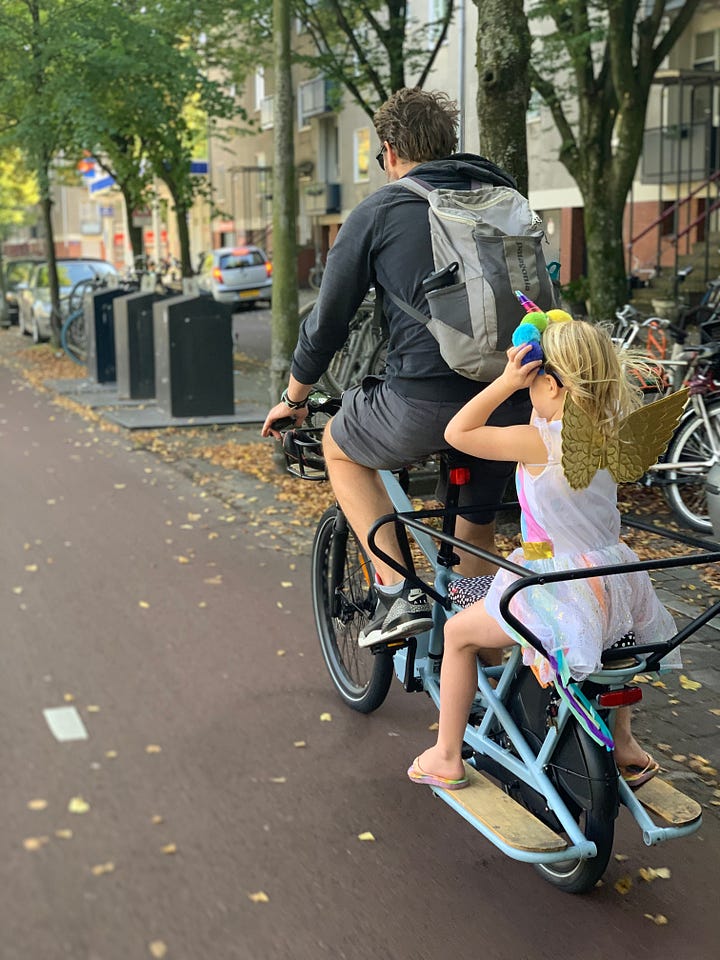
Newcomers need space
You’ll get to notice the subtle cues: wobbly handlebars, nervous head-turning, maybe even a helmet. Be kind to these newcomers - they could be kids, tourists, or even long-time Amsterdammers trying out a bike for the first time, who knows? A little patience and distance goes a long way. And we were all beginners once, right?
Cycling as a starling
From high above, a street in Amsterdam appears filled with clusters of black spots speeding through the city's arteries, stopping here and there, all synchronized at each intersection. Just as you’d observe starlings flying through the sky, cyclists on the street are intrinsically tuned to each other. They form a self-organized system, following the rules of nature. They are neither cars nor fast pedestrians; they have their own logic, much like a flock of birds. Ultimately, their uniform movement lies in the space they share, alert to subtle body cues from co-riders. Each has just enough space to maneuver within the mass. This shared awareness allows cyclists to respond quickly to shifts in the environment, adjusting their speeds and directions with precision. Despite this harmony, the group is not without its outliers. Occasionally, you may observe one dangerously weaving through the crowd at high speed, risking a collision. But aren’t these deviations part of the system’s complexity, adding energy to the collective movement?
Red lights = social time
Rush hour red lights are like mini social gatherings. You’ll find yourself stacked with other cyclists, the perfect time to people-watch, exchange a few words with a stranger, or grin at babies in their seats. But if you’re at the front of the swarm, be ready. Check the countdown timer and get your foot on the pedal with about 5 seconds to go. If you don’t move on time, expect a few "tring-trings" behind you, as people are eager to cut down on waiting time. Dutch lanes are even equipped with smart traffic lights designed for this purpose. Pay attention! A delayed start can frustrate those behind you, especially in such a dense crowd where overtaking is not easy.
Master multi-tasking
You know you’ve made it when you can carry a week’s worth of groceries in one arm, steer with the other, hold a leash, and balance a bouquet on your handlebar. This multitasking is a result of master cycling skills and the ease of combining multiple tasks in one trip, thanks to having all your daily necessities - schools, workplaces, shops, doctors - close by. It’s a near perfect example of the 15-minute city concept (Moreno, 2024), embodied by plenty ofDutch cities, where residents can easily walk or bike anywhere to fulfill their daily needs.
Add to the bicycle ballet with hand signals - sometimes
Turning? Give a brief (left or right) arm wave. Stopping? Same deal. If you don’t, you may get honked at. As the cyclist is stuck behind you, these warnings are invaluable because, while cycling, your brain constantly looks for cues to anticipate the movements of those around you. However, don’t worry too much; cycling is an interactive dance on wheels. If you happen to have your head in the clouds and miss a step, the cyclists around you will likely have anticipated your turn before you even realize it. This tacit process is extremely fast, hard to explain, and yet feels so natural - “You’re kind of protected in this flow of continuous going” (Nello-Deakin & Nikolaeva, 2020:301). So, can we get rid of traffic lights then, you ask? Well, that’s already been tested in some Dutch cities, and guess what? Swarm magic! The traffic ballet regulated itself successfully (te Brömmelstroet et al., 2017).
9) Your bike, our bikes
The saying goes that a bike in the Netherlands is like public property, a semi-disposable commodity that you should expect to get stolen, broken, swapped, or sold off in the black market for very cheap (Nello-Deakin & Nikolaeva, 2021). Bike theft, in this case, is as much an outcome as it is a cause of an urban landscape flooded with cheap bikes. In a nation of cyclists, it’s worth wondering: Could there be such a thing as "bicycle dependency," just like we talk about car dependency?
Finally, before leaving you with your mind wandering along the wobbly streets by the Dutch canals, it may be worth pausing to….
10) Adopt a different take on who’s at stake.
But is it fair to present only one reality of a city’s mobility culture? As highlighted in this article, cycling in the Netherlands isn’t just about riding a bike, it’s a way of life. The country is basically a cycling paradise, where biking is easy, affordable, and a huge time-saver. Add in a bit of social pressure, flat terrain, and the sense of community that comes with being part of the cycling crowd, and it’s no wonder cyclists rule the roads.
But while it might seem like everyone is always on a bike, the reality is more complex. Cycling makes up about a quarter of all trips, yet cars still dominate, with walking coming in a close second (Ministerie van Verkeer en Waterstaat, 2023). And not everyone finds cycling accessible, whether due to physical limitations, affordability, social stigma, discrimination, or just not being comfortable on a bike. Newcomers in cities like Amsterdam, often hesitate to cycle despite the bike-friendly environment (Nello-Deakin & Nikolaeva, 2020). Surprisingly, to date, not much research has been done regarding the barriers to cycling in the Netherlands. If the bike is such a key part of life here, what happens to those who can’t or don’t ride? Does it create a sense of exclusion? That’s a question worth exploring.
Written by Louise Raclet, Researcher at Urban Cycling Institute.
Interested in writing or sponsoring an article? Send us a pitch at media@urbancyclinginstitute.org
Sources:
Boterman, W. R. (2020). Carrying class and gender: Cargo bikes as symbolic markers of egalitarian gender roles of urban middle classes in Dutch inner cities. Social & Cultural Geography, 21(2), 245-264.
EU Urban Mobility Observatory. (2019, August 12). The Netherlands prohibits the use of mobile phones on bicycles. European Commission.
Ministerie van Verkeer en Waterstraat (2023) Cycling facts 2023. Netherlands Institute for Transport Policy Analysis. Mathijs de Haas & Lukas Kolkowski.
Moreno, C. (2024) The 15 Minute City: A Solution to Saving Our Time and Our Planet. New York, NY: Wiley.
Nello-Deakin, S., & Nikolaeva, A. (2020) The human infrastructure of a cycling city: Amsterdam through the eyes of international newcomers. Urban Geography, 42(3), 289–311. https://doi.org/10.1080/02723638.2019.1709757
Kuipers, G. (2013) The rise and decline of national habitus: Dutch cycling culture and the shaping of national similarity. European Journal of Social Theory, 16(1), 17–35.
Samuel Nello-Deakin & Anna Nikolaeva (2021) The human infrastructure of a cycling city: Amsterdam through the eyes of international newcomers, Urban Geography, 42:3, 289-311.
Te Brömmelstroet, M., Nikolaeva, A., Glaser, M., Nicolaisen, M. S., & Chan, C. (2017). Travelling together alone and alone together: mobility and potential exposure to diversity. Applied Mobilities, 2(1), 1-15.






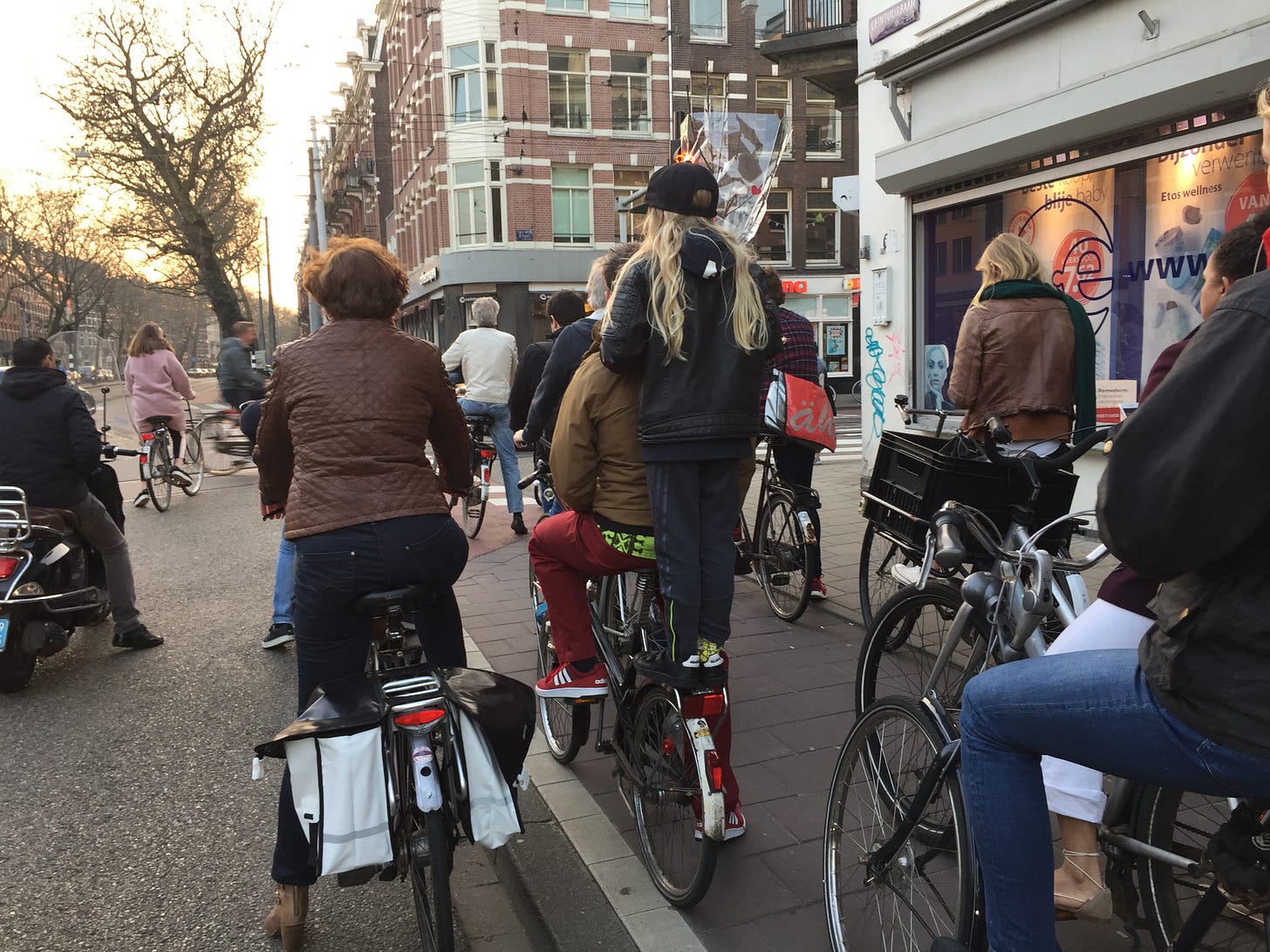
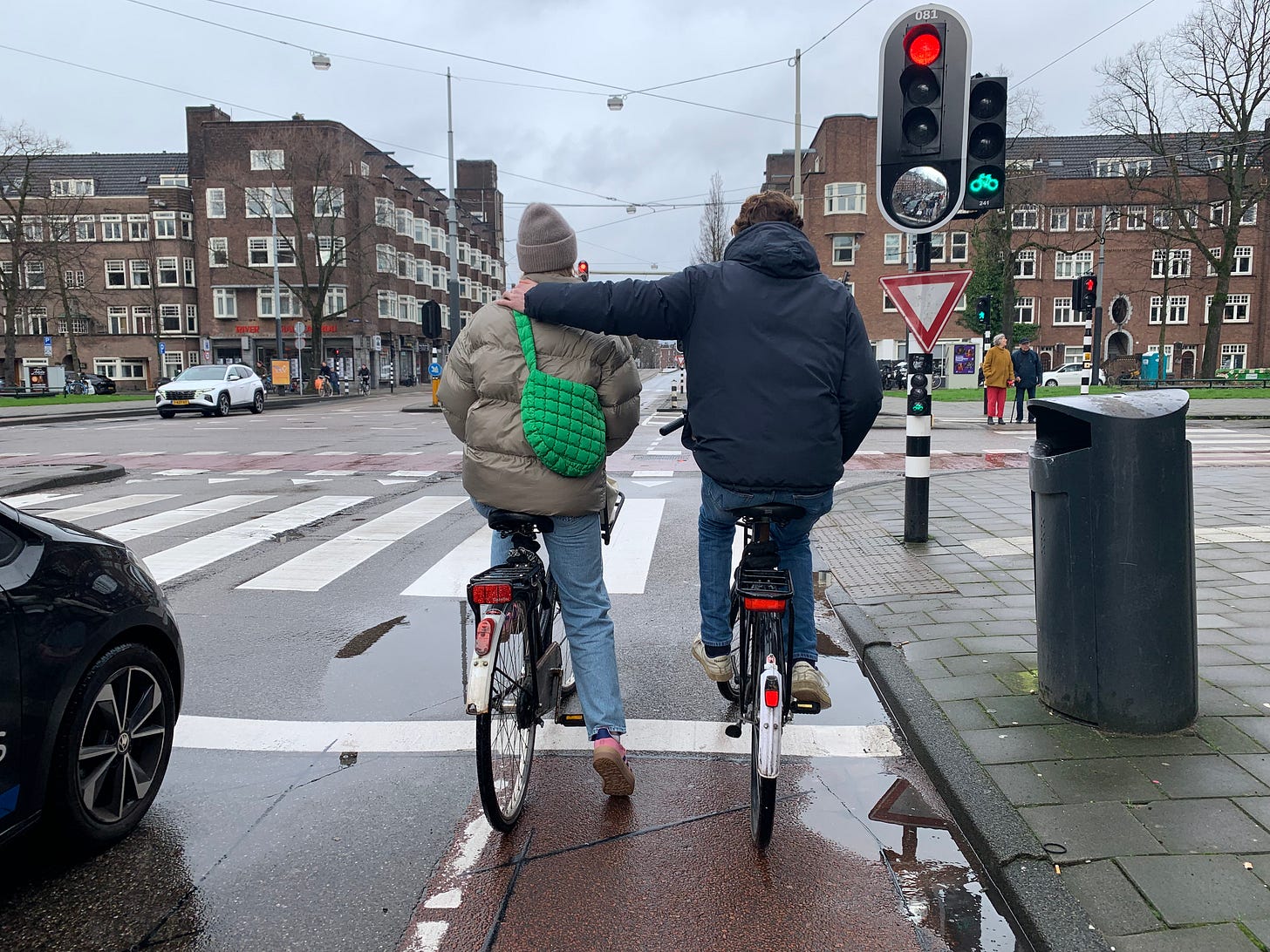
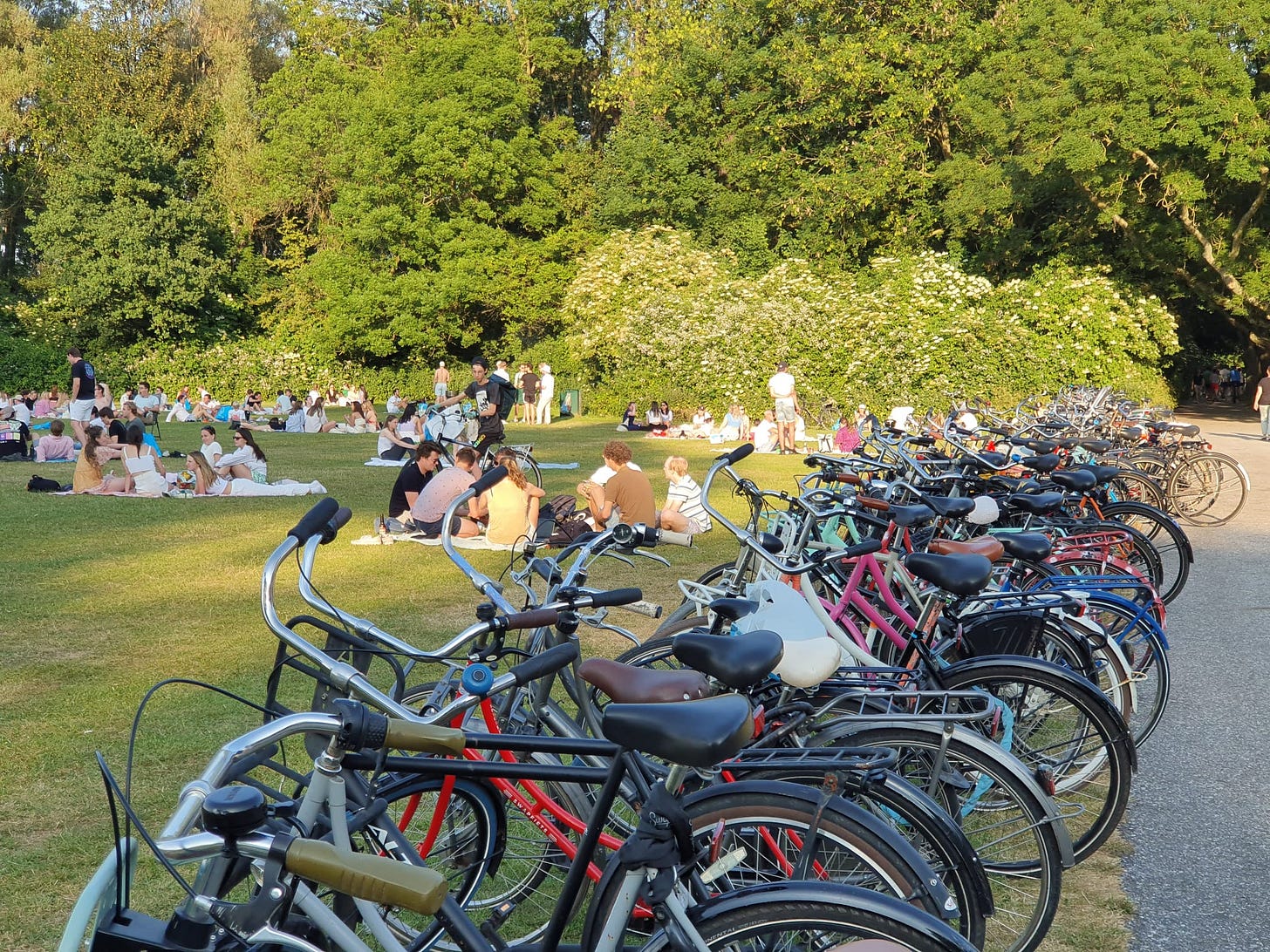

Amazing! Well done! I enjoyed reading this!
Great stuff, I hope to visit this summer, hire a cargo bike and cycle them around like a "elitist career-focused middle-class mum or dad"...... Or tourist...ha!